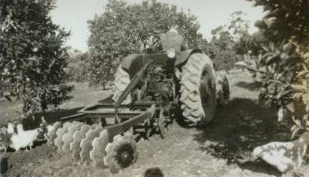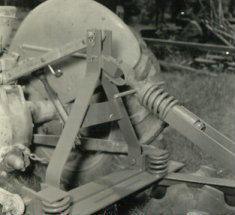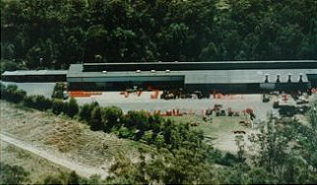ABOUT JARRETT - OUR HISTORY
Over 60 years of experience in every Jarrett product!
When Ferguson introduced its 20 hp, three-point linkage tractor to Australia soon after WWII, only a few implements were available. These included a two-furrow mouldboard plough and a stump-jump tiller. There was no disc cultivator on the market to suit these tractors and farmers had to tow their cultivator on a drawbar using ‘depth wheels’ for control.
Enter Vic Jarrett, a young, ambitious lad from a farming family in the Hills district of Sydney. Vic was a qualified machinist and welder, and local farmers regularly called on him to repair their machinery.
Many of those who called on Vic were orchardists. It was the practice at the time to till the ground between the rows of trees, but the problem was that a cultivator towed on the drawbar was far too rigid and difficult to turn. If the cultivator entered a depression it would cut too deeply and damage the roots of the fruit trees. Vic was determined he could ‘solve’ this problem!

A 14-disc Jarrett Cultivator in action
His answer was Jarrett’s first 3-point linkage disc cultivator. Designed and build by Vic in 1948, its main feature was a sprung headstock which performed a function similar to that of a shock absorber. This feature was unique and gave the Jarrett cultivators a flexibility and evenness which was impossible to achieve with the rigid drawbar system. The back arm of the cultivator was also sprung to take the strain off the frame.
Jarretts manufactured 12, 14 and 16-disc cultivators, the most popular being the 14-disc model with 7 plates on each gang. These early models are similar to the BS series still manufactured by Jarrett today. It is an understatement to say they have “borne the test of time!”

The cultivators strung headstock
Back in that post-war period, manufacturing tools were basic—a power hacksaw for cutting steel, a pedestal grinder for smoothing out welds and burrs, a lathe for machining and a limited range of hand tools. All steel was purchased from McAllister & Williams in Sydney, whilst the discs came from Ralph McKay in Melbourne. A foundry in West Pennant Hills made the castings for the bearings. Interestingly, none of these suppliers exist today!
Vic would take orders over the phone, build each implement by hand, then deliver the finished product. A big breakthrough came when Knight’s Garage in St Ives became a dealer. Knight’s was the main Ferguson tractor (and Vanguard motor vehicle) dealer in the Hills district.
Marshall Motors in Parramatta, a large dealer in Western Sydney, followed soon after. Knight’s and Marshall’s placed orders by the truckload! Word soon spread and dealerships were established in Gosford, Casino, Lismore and further afield. This network of dealers allowed Vic to concentrate on what he did best (and enjoyed the most) … design and manufacture.
Today, Jarrett Implements utilises computer design facilities and fabricates implements with automatic band saws, hydraulic punches, brake presses, computerised lathes and robotic & MIG welders. Nearly all manufacturing processes for the complete range of implements are performed at Jarrett’s 3,000 square metre Dural factory—from cutting lengths of steel to spray painting the finished product.
It’s a complete process where raw steel enters one end and a quality finished product emerges from the other.

Jarrett Implements, then….

… And now!

